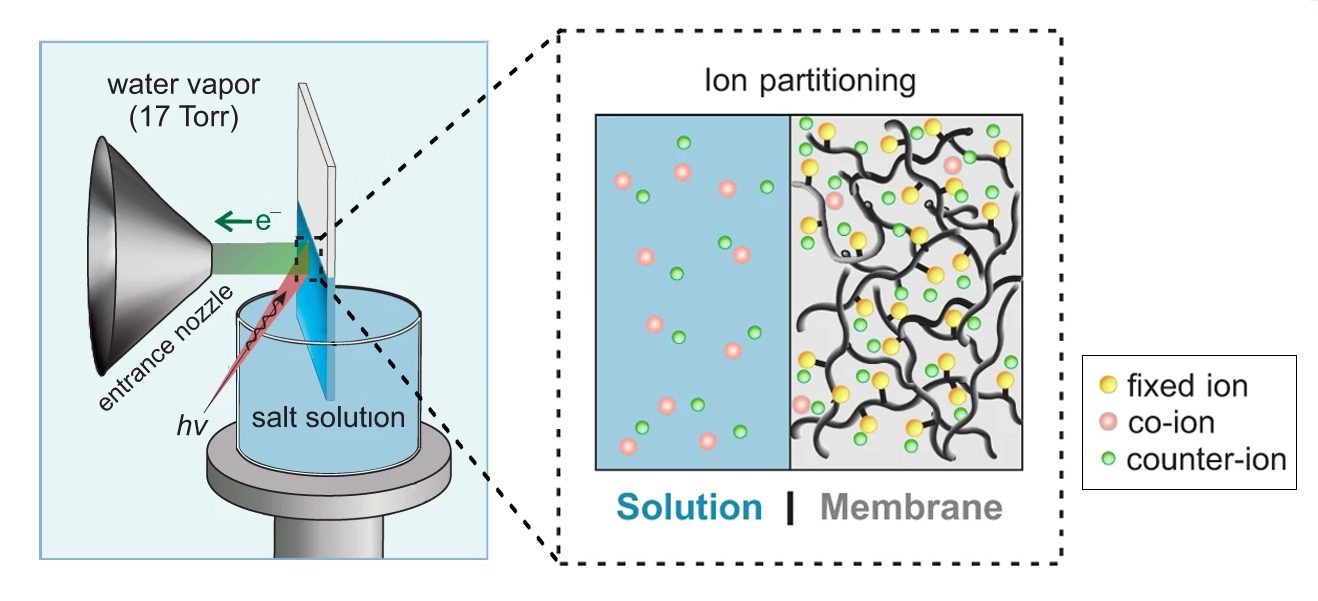SCIENTIFIC ACHIEVEMENT
At the Advanced Light Source (ALS), researchers performed the first direct measurement of the Donnan electrical potential, which arises from an imbalance of charges at membrane-solution interfaces.
SIGNIFICANCE AND IMPACT
Considered unmeasurable for over a century, the Donnan potential is relevant to a wide range of fields, from cell biology to energy storage and water desalination.

A breakthrough with great potential
The Donnan electrical potential arises from an imbalance of charges at the interface of a charged membrane and a liquid, and for more than a century it stubbornly eluded direct measurement. Many researchers had even written off such a measurement as impossible. Now, using ambient-pressure x-ray photoelectrion spectroscopy (APXPS) at the ALS, scientists directly measured the Donnan potential for the first time.
The ability to probe the characteristics of this potential at membrane-solution interfaces could yield new insights in biology, energy science, and materials science. For example, the Donnan potential plays a critical role in biological functions ranging from muscle contractions to neural signaling. Energy storage and water purification using ion exchange membranes (IEMs) are also important applications involving the Donnan potential.
Selective membrane permeability
A key step for many chemical and biological systems is the selective transport of mobile ions in a liquid across a semi-permeable charged membrane. In 1911, British-Irish chemist Frederick Donnan postulated a mechanism for this phenomenon. When a membrane containing fixed ions reaches equilibrium with an electrolyte solution, counter-ions from the solution (with charge opposite that of the membrane’s fixed ions) are electrostatically pulled into the membrane, while co-ions (which have the same charge as the fixed ions) are repulsed. The resulting unequal distribution of ions generates an electrical potential (the Donnan potential) that acts to exclude co-ions from entering the membrane. However, the inability to directly measure this potential has constrained advances that rely on an accurate and precise understanding of the transport phenomena.
Measuring the “unmeasurable”
About 10 years ago, ALS scientists combined APXPS—a technique pioneered at the ALS—with higher-energy x-rays. In the work described here, the researchers used such higher-energy “tender” x-rays (4 keV) at Beamline 9.3.1 to enable photoelectrons emitted from a buried interface region to pass through dense liquid and solid phases for detection. Until recently, the ALS was the only place in the world where this could be done at a solid-liquid interface.
The samples consisted of a commercial IEM dipped into monovalent and divalent aqueous salt solutions (NaCl and MgCl2). The membranes were pulled from the solution, leaving a thin layer of solution about 17–20 nm thick. These were then measured under equilibrium conditions using tender x-rays. To help validate the experiments, team members compared the measured Donnan potential values to simulated thermodynamic models.
Next level unlocked
By detecting shifts in the binding energies of membrane-related core levels, the experiments directly revealed how the Donnan potential depends on external salt concentration and counter-ion valence. In addition, the researchers showed that the classic Donnan model assuming ideal behavior fails to predict experimentally measured Donnan potentials, while an improved model (Donnan/Manning) incorporating some of the thermodynamic nonidealities shows reasonable correlation.
In the future, the researchers plan to explore more complex membrane-electrolyte systems, with improvements in the experimental set-up that will enhance the spectral resolution and signal-to-noise ratio. Overall, the work establishes a foundation for directly studying ion transport across charged-membrane interfaces, unlocking previously inaccessible fundamental properties, especially for systems deviating from ideal behavior that have been challenging to address theoretically due to limitations in current models.

Contact: Ethan Crumlin
Researchers: P. Aydogan Gokturk (ALS); R. Sujanani, L.E. Katz, and B.D. Freeman (The University of Texas at Austin); and J. Qian, Y. Wang, and E.J. Crumlin (Berkeley Lab and ALS).
Funding: Center for Materials for Water and Energy Systems (M-WET), an Energy Frontier Research Center funded by the U.S. Department of Energy (DOE), Office of Science, Basic Energy Sciences (BES) program; Early Career Award in the Condensed Phase and Interfacial Molecular Science Program, DOE BES. Operation of the ALS is supported by DOE BES.
Publication: P. Aydogan Gokturk, R. Sujanani, J. Qian, Y. Wang, L.E. Katz, B.D. Freeman, and E.J. Crumlin, “The Donnan Potential Revealed,” Nat. Commun. 13, 5880 (2022), doi:10.1038/s41467-022-33592-3.
Adapted from the Berkeley Lab news release, “The Donnan Potential, Revealed at Last.”
ALS SCIENCE HIGHLIGHT #476